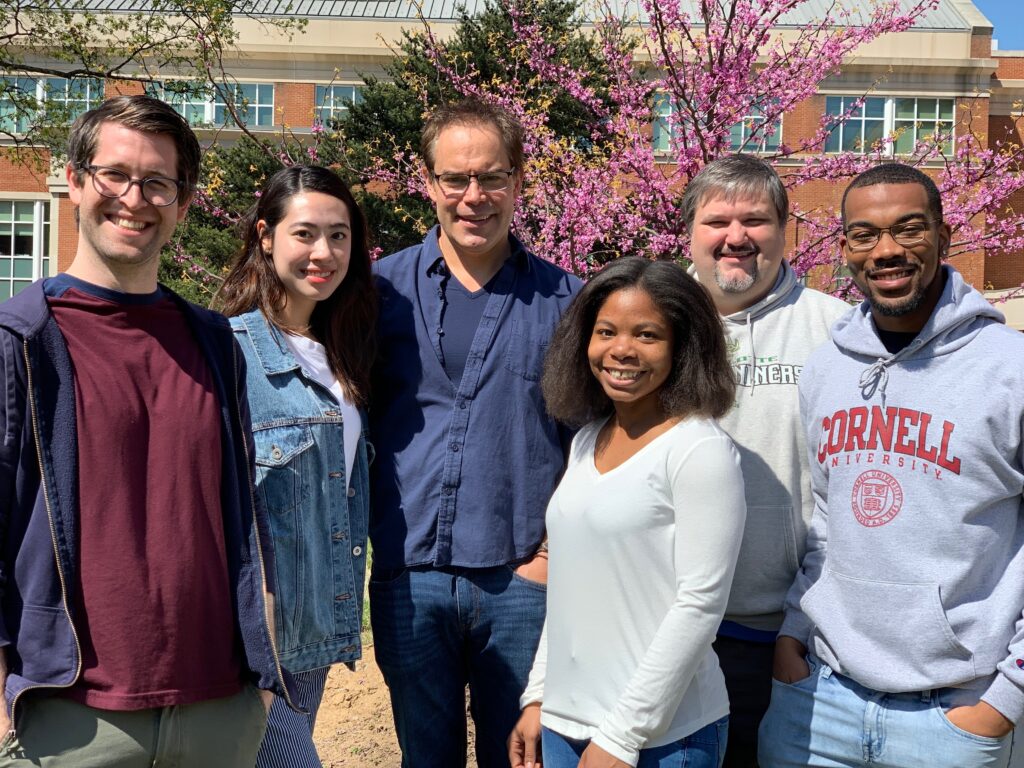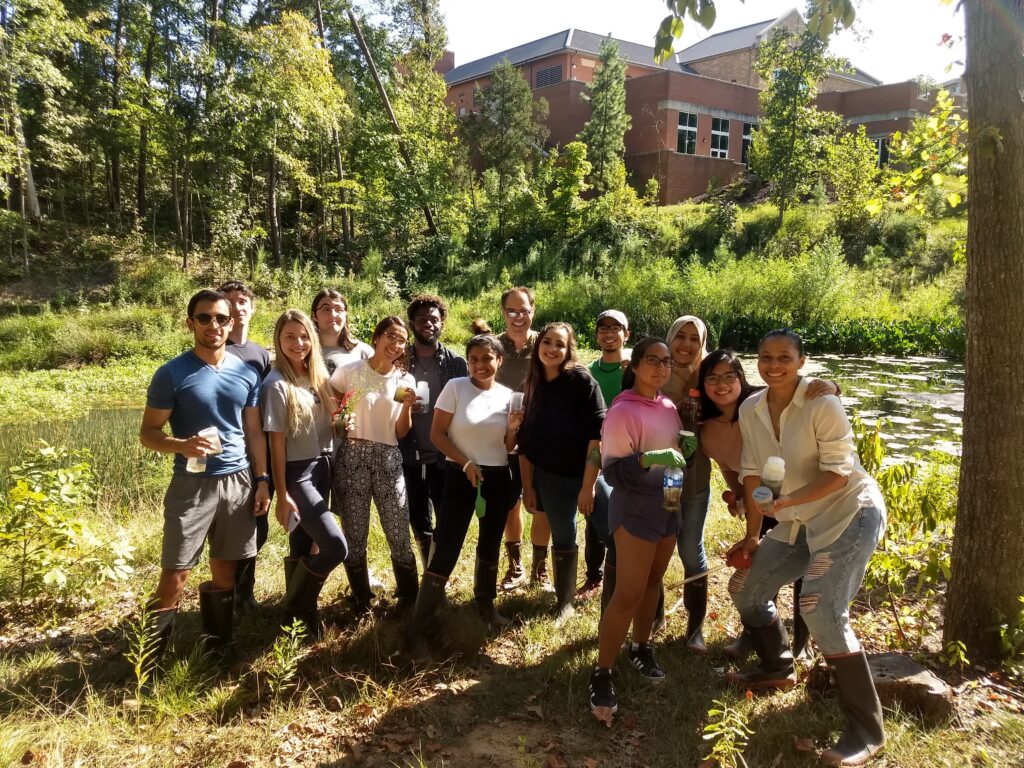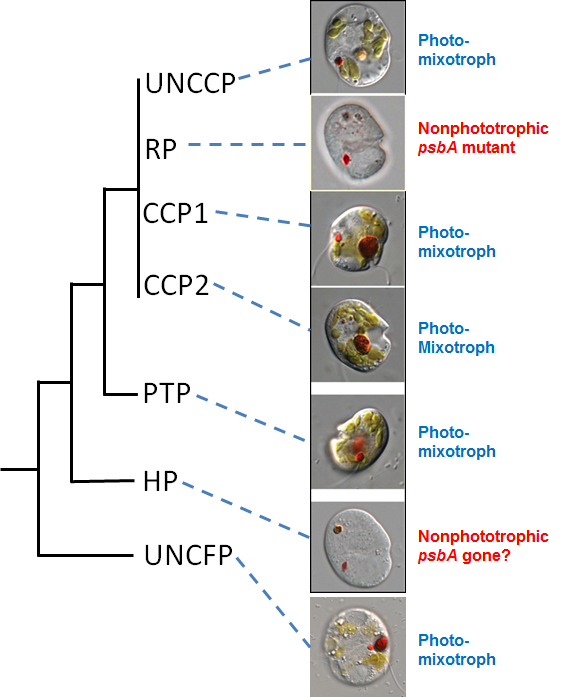Full-Text Search
Matthew Parrow
Dr. Matthew W. Parrow
Google Scholar Profile
Research Gate Profile

We study harmful algal blooms, ecology and biodiversity of eukaryotic microbes, and applications of algae and fungi in biotechnology
Academic Degrees
PhD Plant and Microbial Biology, North Carolina State University
BS Biology, University of North Carolina Chapel Hill
Courses Taught at UNC Charlotte
BIOL 3111 – Cell Biology
BIOL 3144L – Ecology Laboratory
BIOL 3272 – Plant Physiology
BIOL 4000/5000 – Biology of Algae
BIOL 4000/5000 – Tree of Life – Eukaryotes
BIOL 6010/8010 – Eukaryotic Microbiology

Eukaryotes (cells with a nucleus) are a domain of life that has occupied Earth for ~1.5 billion years. Multicellular eukaryotes (animals and plants) are familiar to everyone. However, these groups form only a few branches in the amazing evolutionary tree of eukaryotic diversity. The other eukaryotes are mostly microscopic, single-celled organisms commonly called algae, protists or microbial eukaryotes. They occur in all ecosystems and exert profound effects on the planet and all life, ranging from economically and environmentally-destructive Harmful Algal Blooms to forming the base of the marine food web and providing the majority of oxygen to the biosphere.
Research in my laboratory focuses on the ecology, diversity and evolution of microbial eukaryotes. Specific topics include ecology of harmful algal blooms, biodiversity and evolution of protists, and use of algae and fungi in biotechnology such as biofuel production.
If you are a student interested in microbiology, ecology, evolution, or biotechnology, please feel free to contact Dr. Parrow.
Selected Publications
Gaspar TR, Chi RJ, Parrow MW, Ringwood AH (2018) Cellular bioreactivity of micro- and nano- plastic particles in oysters. Frontiers in Marine Science 5:1-8.
Lira B, Parrow MW, Tavera R (2017) Morphology and ecology of freshwater-blooming Durinskia baltica (Dinophyceae: Peridiniales) in Xochimilco, Mexico. Microbiology Research Journal International 18: 1-15
Carty S, Parrow MW (2015) Dinoflagellates. In Wehr JD & Sheath RG [eds] Freshwater Algae of North America: Ecology and Classification, 2nd Ed. Academic Press, Boston, USA, pp. 773-807
Giles RL, Zackeru JC, Galloway ER, Elliott GD, Parrow MW (2015) Single versus simultaneous species treatment of wood with Ceriporiopsis subvermispora and Postia placenta for ethanol applications, with observations on interspecific growth inhibition. International Biodeterioration & Biodegradation 99:66-72
Chi J, Parrow MW, Dunthorn M (2014) Cryptic sex in Symbiodinium (Alveolata, Dinoflagellata) is supported by an inventory of meiotic genes. Journal of Eukaryotic Microbiology 61:322-327
Fawcett RC, Parrow MW (2014) Mixotrophy and loss of phototrophy among geographical isolates of freshwater Esoptrodinium/Bernardinium sp. (Dinophyceae). Journal of Phycology 50:55-70
Giles RL, Galloway ER, Zackeru JC, Naithani V, Parrow MW (2014) Two stage fungal biopulping solubilizes lignocellulosic carbohydrates without supplemental enzymatic hydrolysis. International Biodeterioration & Biodegradation 86:265-271
Fawcett RC, Parrow MW (2012) Cytological and phylogenetic diversity of freshwater Esoptrodinium/Bernardinium species (Dinophyceae). Journal of Phycology 48:793-807
Giles RL, Zackeru JC, Elliott GD, Parrow MW (2012) Fungal growth necessary but not sufficient for effective biopulping of wood for lignocellulosic ethanol applications. International Biodeterioration and Biodegredation 67:1-7
Giles RL, Galloway ER, Elliott GD, Parrow MW (2011) Two-stage fungal biopulping for improved enzymatic hydrolysis of wood. Bioresource Technology 102:8011-8016
Skelton HM, Burkholder JM, Parrow MW (2009) Axenic culture of the heterotrophic dinoflagellate Pfiesteria shumwayae in a semi-defined medium. Journal of Eukaryotic Microbiology 56:73-82
Skelton HM, Burkholder JM, Parrow MW (2008) Axenic cultivation of the heterotrophic dinoflagellate Pfiesteria shumwayae and observations on feeding behavior. Journal of Phycology 44:1614-1624
Burkholder JM, Hallegraeff GM, Melia G, Cohen A, Bowers HA, Oldach DW, Parrow MW, Sullivan MJ, Zimba PV, Allen EH, Kinder CA, Mallin MA (2007) Phytoplankton and bacterial assemblages in ballast water of U.S. military ships as a function of port of origin, voyage time, and ocean exchange practices. Harmful Algae 6:486-518
Parrow MW, Elbrächter M, Krause MK, Burkholder JM, Deamer NJ, Htyte N, Allen EH (2006) The taxonomy and growth of a Crypthecodinium species (Dinophyceae) isolated from a brackish water fish aquarium. African Journal of Marine Science 28:185-191
Glibert PM, Burkholder JM, Parrow MW, Lewitus AJ, Gustafson DE (2006) Direct uptake of nitrogen and nitrogen nutritional preferences by Pfiesteria piscicida and Pfiesteria shumwayae. Harmful Algae 5:380-394
Kremp A, Parrow MW (2006) Evidence for asexual resting cysts in the life cycle of the marine peridinoid dinoflagellate, Scrippsiella hangoei. Journal of Phycology 42:400-409
Lewitus AJ, Wetz MS, Willis BM, Burkholder JM, Parrow MW, Glasgow HB (2006) Grazing activity of Pfiesteria piscicida (Dinophyceae) and susceptibility to ciliate predation vary with toxicity status. Harmful Algae 5:427-434
Marshall HG, Hargraves PE, Burkholder JM, Parrow MW, Elbrächter M, Allen EH, Knowlton VM, Rublee PA, Hynes WL, Egerton TA, Remington DL, Wyatt KB, Coyne KJ, Lewitus AJ, Henrich VC (2006) Taxonomy of Pfiesteria (Dinophyceae). Harmful Algae 5:481-496
Skelton HM, Parrow MW, Burkholder JM (2006) Phosphatase activity in the heterotrophic dinoflagellate Pfiesteria shumwayae. Harmful Algae 5:395-406
Glibert PM, Seitzinger S, Heil CA, Burkholder JM, Parrow MW, Codispoti LA, Kelly V (2005) The role of eutrophication in the global proliferation of harmful algal blooms – new perspectives and new approaches. Oceanography 18:198-209
Parrow MW, Burkholder JM, Deamer NJ, Ramsdell JS (2005) Contaminant-free cultivation of Pfiesteria shumwayae (Dinophyceae) on a fish cell line. Aquatic Microbial Ecology 39:97-105
Parrow MW, Burkholder JM (2004) Observations on zygote development and postzygotic divisions in Pfiesteria piscicida and cryptoperidiniopsoids (Dinophyceae). Harmful Algae 3:239-240
Parrow MW, Burkholder JM (2004) The sexual life cycles of Pfiesteria piscicida and cryptoperidiniopsoids (Dinophyceae). Journal of Phycology 40:664-673
Parrow MW, Deamer NJ, Alexander JL, Burkholder JM (2004) A cell cycle synchronization and culture purification technique for heterotrophic Pfiesteria and cryptoperidiniopsoid dinoflagellates analyzed by flow cytometry. Steidinger KA, et al. (Eds) Proceedings of the Tenth International Conference on Harmful Algae. IOC UNESCO, Paris, pp. 420-422
Parrow MW, Burkholder JM (2003) Reproduction and sexuality in Pfiesteria shumwayae (Dinophyceae). Journal of Phycology 39:697-711
Parrow MW, Burkholder JM (2003) Estuarine heterotrophic cryptoperidiniopsoids (Dinophyceae): life cycle and culture studies. Journal of Phycology 39:678-696
Parrow MW, Burkholder JM, Deamer NJ, Zhang C (2002) Vegetative and sexual reproduction in Pfiesteria spp. (Dinophyceae) cultured with algal prey, and inferences for their classification. Harmful Algae 1:5-33
Parrow MW, Burkholder JM (2002) Flow cytometric determination of zoospore DNA content and population DNA distribution in cultured Pfiesteria spp. (Pyrrhophyta). Journal of Experimental Marine Biology and Ecology 267:35-51
Stoecker DK, Parrow MW, Burkholder JM, Glasgow HB (2002) Grazing by microzooplankton on Pfiesteria piscicida with different histories of toxicity. Aquatic Microbial Ecology 28:79-85
Parrow MW, Glasgow HB, Burkholder JM, Zhang C (2001) Comparative response to algal prey by Pfiesteria piscicida, Pfiesteria shumwayae, and an estuarine ‘lookalike’ species. Hallegraeff GM, Blackburn S, Bolch CJ, Lewis RJ (Eds) Harmful Algal Blooms 2000, Proceedings of the Ninth International Conference on Harmful Algal Blooms. IOC UNESCO, Paris, pp. 101-104
Burkholder JM, Glasgow HB, Deamer-Melia NJ, Springer J, Parrow MW, Zhang C, Cancellieri PJ (2001) Species of the toxic Pfiesteria complex and the importance of functional type in data interpretation. Environmental Health Perspectives 109:667-686
Glasgow HB, Burkholder JM, Morton SL, Springer J, Parrow MW (2001) Fish-killing activity and nutrient stimulation of a second toxic Pfiesteria species. Hallegraeff GM, Blackburn S, Bolch CJ, Lewis RJ (Eds) Harmful Algal Blooms 2000, Proceedings of the Ninth International Conference on Harmful Algal Blooms. IOC UNESCO, Paris, pp. 97-100
Bralower TJ, Parrow MW (1996) Morphometrics of the Paleocene coccolith genera Cruciplacolithus, Chiasmolithus, and Sullivania: a complex evolutionary history. Paleobiology 22:352-385
Bralower TJ, Parrow MW, Thomas E, Zachos JC (1995) Stable isotopic stratigraphy of the Paleocene pelagic cap at Site 865, Allison Guyot. Proceedings of the Ocean Drilling Program, Scientific Results 143:581-586
Bralower TJ, Zachos JC, Thomas E, Parrow MW, Paull CK, Kelly DC, Silva P, Sliter WV, Lohmann KC (1995) Late Paleocene to Eocene paleoceanography of the equatorial Pacific Ocean: stable isotopes recorded at Ocean Drilling Program Site 865, Allison Guyot. Paleoceanography 10:841-865

Phylogenetic tree inferring evolutionary trophic adaptations in Esoptrodinium sp. flagellates






